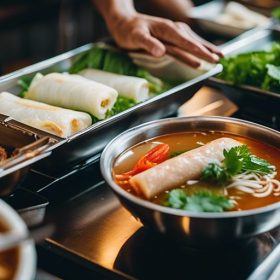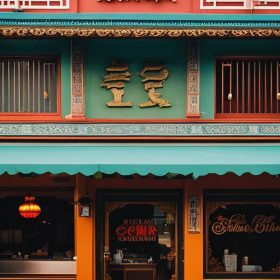Vietnamese cuisine has been gaining popularity around the world in recent years. Known for its fresh ingredients, vibrant flavors, and healthy cooking techniques, Vietnamese food has become a favorite among food enthusiasts and health-conscious individuals. As a result, the demand for Vietnamese ingredients and products has increased, leading to a growing trend of importing Vietnamese foods.
There are several reasons why importing Vietnamese foods is becoming more common. Firstly, people are becoming more adventurous with their food choices and are seeking out new and exciting flavors. Vietnamese cuisine offers a unique blend of flavors that is different from other Asian cuisines, making it an attractive option for those looking to try something new.
Secondly, the health benefits of Vietnamese cuisine have also contributed to its popularity. Vietnamese dishes are typically low in fat and calories, and they often incorporate fresh herbs, vegetables, and lean proteins. This makes Vietnamese food a nutritious choice for those looking to maintain a healthy diet.
The Benefits of Eating Vietnamese Foods
Vietnamese cuisine offers a range of health benefits that make it an excellent choice for those looking to improve their overall well-being. One of the key benefits of Vietnamese food is its emphasis on fresh ingredients. Vietnamese dishes often include a variety of herbs, vegetables, and fruits, which are packed with essential vitamins and minerals.
Additionally, Vietnamese cuisine is known for its use of lean proteins such as fish, chicken, and tofu. These proteins are low in fat and provide a good source of nutrients. The cooking techniques used in Vietnamese cuisine also help to preserve the nutritional value of the ingredients, as they often involve steaming or stir-frying rather than deep-frying.
Another benefit of Vietnamese food is its unique flavors. Vietnamese dishes often incorporate a combination of sweet, sour, salty, and spicy flavors, creating a complex and satisfying taste profile. The use of fresh herbs such as mint, cilantro, and basil adds a refreshing and aromatic element to the dishes.
Understanding the Import Process and Regulations
Importing food products can be a complex process, and it is important to understand the steps involved and the regulations and requirements that need to be met. When it comes to importing Vietnamese foods, there are several key considerations to keep in mind.
The first step in the import process is to identify a reputable importer who specializes in Vietnamese foods. This is important as they will have the knowledge and experience to navigate the import regulations and ensure that the products meet the necessary standards.
Once a suitable importer has been identified, the next step is to determine the specific regulations and requirements for importing Vietnamese foods. This can vary depending on the country of import, but typically involves obtaining the necessary permits and certifications, ensuring compliance with food safety standards, and meeting labeling requirements.
It is also important to consider logistics such as shipping and storage requirements. Vietnamese foods often require specific handling and storage conditions to maintain their freshness and quality during transportation. Working closely with the importer to ensure that these requirements are met will help to ensure a smooth import process.
Choosing the Right Importer: Factors to Consider
Choosing the right importer is crucial when it comes to importing Vietnamese foods. A reputable importer will have a good understanding of the Vietnamese food industry, as well as the necessary expertise to navigate the import process.
One of the key factors to consider when choosing an importer is their experience and track record. Look for an importer who has a proven track record of successfully importing Vietnamese foods and has established relationships with suppliers in Vietnam. This will help to ensure that they have a good understanding of the market and can source high-quality products.
Another important factor to consider is their knowledge of food safety regulations and requirements. Importing food products involves strict regulations around food safety, labeling, and packaging. It is important to choose an importer who is well-versed in these regulations and can ensure that the products meet the necessary standards.
Additionally, consider the importer’s ability to handle logistics such as shipping and storage. Vietnamese foods often require specific handling and storage conditions to maintain their freshness and quality. Working with an importer who has experience in handling these requirements will help to ensure that the products arrive in optimal condition.
Popular Vietnamese Foods to Import and Where to Find Them
There are several popular Vietnamese foods that are commonly imported and enjoyed around the world. These include ingredients such as fish sauce, rice noodles, and Vietnamese coffee, as well as ready-to-eat products like spring rolls and banh mi sandwiches.
Fish sauce is a staple ingredient in Vietnamese cuisine and is used to add depth of flavor to dishes. It is made from fermented fish and has a salty, savory taste. Rice noodles are another essential ingredient in Vietnamese cooking, used in dishes such as pho and bun cha.
Vietnamese coffee is known for its strong flavor and smooth texture. It is typically made with dark roast coffee beans and served with condensed milk. Ready-to-eat products like spring rolls and banh mi sandwiches are also popular choices for those looking for a quick and convenient meal.
These products can be found at specialty Asian grocery stores or online retailers that specialize in imported foods. It is important to choose a reputable retailer or importer to ensure that the products are of high quality and meet the necessary standards.
Ensuring Quality and Authenticity: Tips for Selecting the Best Products
When importing Vietnamese foods, it is important to ensure that the products are of high quality and authentic. There are several tips to keep in mind when selecting the best products.
Firstly, look for products that have been sourced directly from Vietnam. This will help to ensure that the products are authentic and have been produced using traditional methods. Avoid products that have been produced outside of Vietnam but claim to be Vietnamese.
Secondly, pay attention to the packaging and labeling of the products. Authentic Vietnamese products will often have labels in Vietnamese, as well as English translations. Look for products that have clear and accurate labeling, including information on ingredients, nutritional content, and any certifications or quality marks.
It is also important to consider the reputation of the brand or producer. Look for brands that have a good reputation for producing high-quality Vietnamese foods. This can often be determined through online reviews or recommendations from other customers.
Finally, consider the price of the products. While it is important to find products that are reasonably priced, be wary of products that are significantly cheaper than others on the market. This could be an indication of lower quality or counterfeit products.
Packaging and Shipping: Best Practices for Safe and Secure Delivery
Packaging and shipping are key considerations when it comes to importing Vietnamese foods. Proper packaging is essential to ensure that the products arrive in optimal condition, while secure shipping helps to prevent damage or spoilage during transportation.
When it comes to packaging, choose materials that are suitable for the specific products being imported. For example, perishable items may require insulated packaging or cold packs to maintain their freshness. Dry goods may require sturdy packaging to prevent breakage.
It is also important to label the packages clearly with information such as the contents, handling instructions, and any necessary warnings. This will help to ensure that the packages are handled correctly during transportation.
When it comes to shipping, choose a reputable shipping company that specializes in transporting food products. They will have the necessary expertise and equipment to handle the specific requirements of importing Vietnamese foods.
Additionally, consider the shipping method and timeframe. Some Vietnamese foods may require expedited shipping to ensure that they arrive in optimal condition. Discuss these options with the shipping company to determine the best method for your specific needs.
Handling Customs and Duties: What You Need to Know
Importing Vietnamese foods involves navigating customs and duties, which can vary depending on the country of import. It is important to understand the specific requirements and regulations in order to ensure a smooth import process.
Customs regulations typically involve providing documentation such as invoices, packing lists, and permits. These documents will need to be submitted to customs authorities for inspection and clearance. It is important to work closely with the importer to ensure that all necessary documentation is provided and that it meets the requirements of the customs authorities.
Duties and taxes may also be applicable when importing Vietnamese foods. These fees are typically based on the value of the goods being imported and are determined by the customs authorities. It is important to factor these costs into your budget when planning to import Vietnamese foods.
Working with a reputable importer who has experience in navigating customs and duties can help to ensure a smooth import process. They will have a good understanding of the specific requirements and can provide guidance and support throughout the process.
Storing and Handling Imported Foods: Best Practices for Maintaining Freshness
Proper storage and handling are essential for maintaining the freshness and quality of imported Vietnamese foods. Different products may have specific storage requirements, so it is important to follow the instructions provided by the importer or manufacturer.
Perishable items such as fresh herbs or seafood should be stored in the refrigerator or freezer to maintain their freshness. Dry goods should be stored in a cool, dry place away from direct sunlight or heat sources.
It is also important to handle the products with care to prevent damage or spoilage. Avoid exposing perishable items to extreme temperatures or rough handling during transportation or storage.
Additionally, pay attention to expiration dates and shelf life information provided on the packaging. Consuming products past their expiration date can pose health risks, so it is important to discard any expired items.
Incorporating Vietnamese Foods into Your Diet: Recipe Ideas and Inspiration
Once you have imported Vietnamese foods, there are many ways to incorporate them into your diet. Vietnamese cuisine offers a wide range of flavors and ingredients that can be used in a variety of dishes.
One popular way to enjoy Vietnamese ingredients is by making traditional dishes such as pho, banh mi, or spring rolls. These dishes are not only delicious but also showcase the unique flavors and ingredients of Vietnamese cuisine.
You can also use Vietnamese ingredients to add flavor to other dishes. For example, fish sauce can be used as a marinade or seasoning for meats and vegetables. Rice noodles can be used in stir-fries or salads. Vietnamese coffee can be enjoyed as a refreshing iced coffee or used in desserts.
Experimenting with different recipes and flavors is a great way to explore the versatility of Vietnamese ingredients and discover new favorite dishes.
Bringing the Flavors of Vietnam to Your Table
Importing Vietnamese foods offers the opportunity to bring the flavors of Vietnam to your table. With its emphasis on fresh ingredients, vibrant flavors, and healthy cooking techniques, Vietnamese cuisine is a great choice for those looking to explore new flavors and improve their overall well-being.
By understanding the import process and regulations, choosing a reputable importer, ensuring quality and authenticity, and following best practices for packaging, shipping, and storage, you can enjoy high-quality Vietnamese foods in the comfort of your own home.
So why not give it a try? Explore the world of Vietnamese cuisine and bring the flavors of Vietnam to your table today.

Cuong Nguyen is a talented writer and experienced waitress at Vietnampalace.net, a renowned Vietnamese restaurant that offers an extensive menu of authentic Vietnamese cuisine. With a background in the competition of Vietnamese cuisine, Cuong brings a wealth of knowledge and expertise to the dining experience. From delicious pho dishes to fresh spring rolls, Cuong ensures that every meal is made with the freshest ingredients and authentic flavors.With exceptional service and a friendly atmosphere, Cuong takes pride in providing a memorable dining experience for every customer.
Whether you’re a vegetarian looking for options or a meat lover craving the flavors of traditional Vietnamese dishes, Cuong guarantees a delightful culinary adventure. So, visit Vietnampalace.net and let Cuong guide you through the tantalizing world of Vietnamese cuisine.



